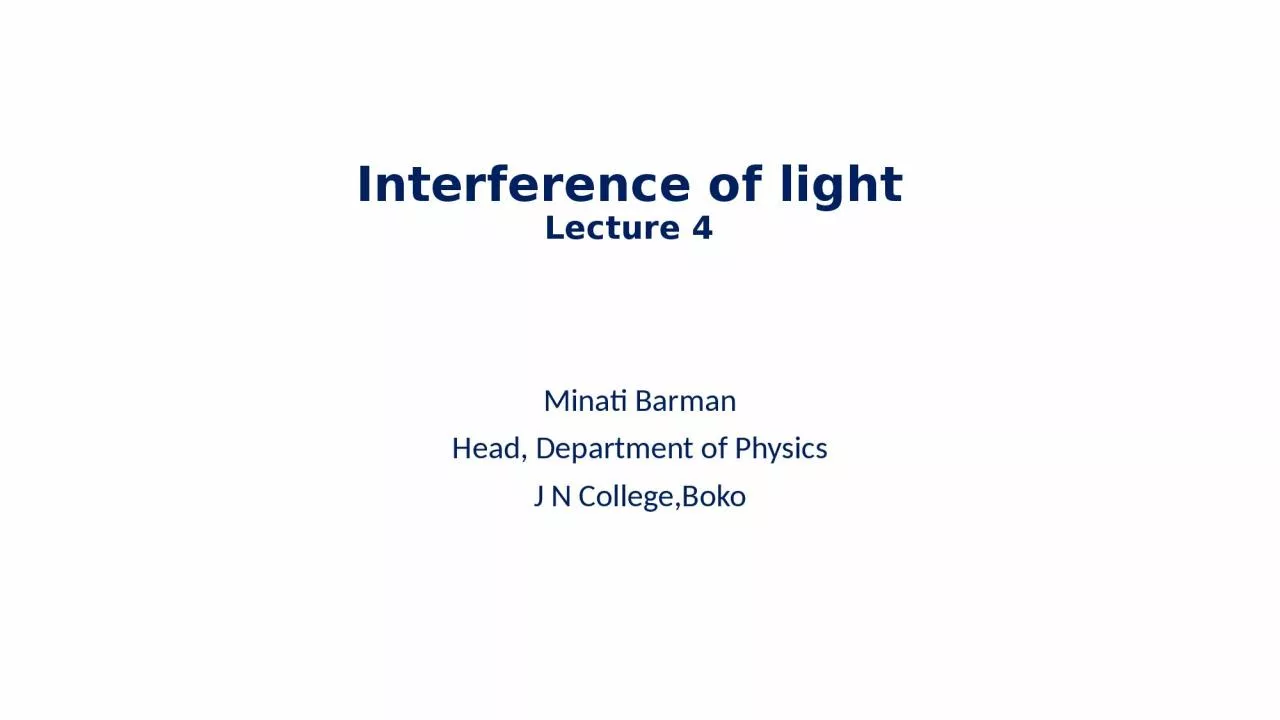

Minati Barman Head Department of Physics J N CollegeBoko Contents Conditions of observable interference Fresnels biprism Experiment Conditions of observable interference To obtain welldefined interference fringes following conditions must be satisfied ID: 931311
Download Presentation The PPT/PDF document "Interference of light Lecture 4" is the property of its rightful owner. Permission is granted to download and print the materials on this web site for personal, non-commercial use only, and to display it on your personal computer provided you do not modify the materials and that you retain all copyright notices contained in the materials. By downloading content from our website, you accept the terms of this agreement.
Slide1
Interference of lightLecture 4
Minati
Barman
Head, Department of Physics
J N
College,Boko
Slide2Contents:Conditions of observable interferenceFresnel’s biprism Experiment
Conditions of observable interference:
To obtain well-defined interference fringes following conditions must be satisfied-
When the phase difference between two sources remain constant then the sources are called as coherent sources
.
To get observable interference pattern the two interfering
light beams must be coherent.
The frequency of the interfering wave must be same.
The original source must be monochromatic.
The two interfering waves must propagate along the same direction or must intersect at a very small angle.
Slide3Biprism Experiment: A biprism is consisted of two right angled prisms with very small refracting angles ( ̴ 1/2 ͦ) placed base to base. Suppose
the
monochromatic light from a slit S, perpendicular to the plane of the
paper, falls symmetrically on the biprism, the refracting edge of which is perpendicular to the paper. The edge B of the biprism divides the incident wave-front into two parts and hence appear to diverge from two virtual images S1 and S2. These two images now serve as the two coherent sources . Consequently, interference fringes are observed on the overlapping region of the two emergent beams of light.
Slide4The fringe width β of monochromatic light is given by
β
=λD/d .So The wavelength of monochromatic source of light can be calculated by the formula λ= βd/D .where β = fringe width i.e., the distance between two successive
maxima or minima of
the fringesd = distance between the two virtual sources S1 &S2D
= distance between the
slit and
screen or eye-piece where the
fringe are
observed and measured.
Slide5Experiment:The optical bench is levelled by a sprit level and the levelling screws. Light source and slit is arranged in order to get the maximum light incident on the slit. The centre of slit, biprism and eye piece is arranged at same height and made vertical.
To get
clear fringe pattern
the edge of biprism is adjusted by rotating screw. If the line joining the slit and the central edge of the biprism is not parallel to the length of the bench, fringes would shift laterally as the eye-piece is moved. To remove lateral shift, the biprism is moved a small distance transversely to the bench in a direction opposite to the direction of the shift till this lateral shift vanishes.Measurement of fringe widthβ and D:The fringe width β is measured by putting the cross wire at successive bright or dark fringes. The distance D is measured directly from the bench scale which is the distance between the slit and the eyepiece.
Slide6Measurement of d: For measurement of d, a lens of short focal length is inserted between the slit and the eye-piece. The eye-piece is moved away from the
slit,
so that the distance between the slit and the eye-piece is greater than four times the focal length of the convex lens used .
Without changing the position of the slit and biprism; a convex lens is mounted on the optical bench between the biprism and eyepiece. For two positions of the lens on the optical bench we get two clear images of the slit. The distances d1 and d2 between the two well-defined images for the two positions of the lens are measured with the micrometre screw. Now geometrically it can be shown that the distance between the two slits d
= √(d₁d₂)
Slide7Measurement of the acute angle of the biprism:If ∂ be the angular deviation of the rays coming
from the
coherent sources passing through the two prisms, then angular separation of the two coherent sources is 2∂. But we know that ∂ = (n-1)α where α is an acute angle. If a be the distance of separation between the source and the biprism, then 2∂=d/a here d is distance of separation between the two coherent sources which is very small.
Therefore
2(n-1)α =d/a
or
d= 2a(n-1)
α
Measuring a and d and knowing n, the refractive index of the medium we can find acute angle
α
.
Slide8Measurement of thickness of a thin film :
If we place a thin film of thickness t on the path of the wave coming from the coherent source as shown in the figure, then the position of the central fringe will be shifted from C to P so that the optical path S₁P and S₂P become equal. Thus
S₂P/c=(S₁P-t)/c + t/v here v is the velocity of light in film. S₂P-S₁P = (n-1)t
Slide9If P be the position of the mth
order bright fringe
originally then
S₂P-S₁P = mλ (n-1)t =mλNow if β
be
fringe width then Xm= β
m where
β=λ
D/d .
Therefore (n-1)t =
(
X
m
/β ).
λ where m=Xm/β. t= t= This is the equation for measuring the thickness of the film. *********